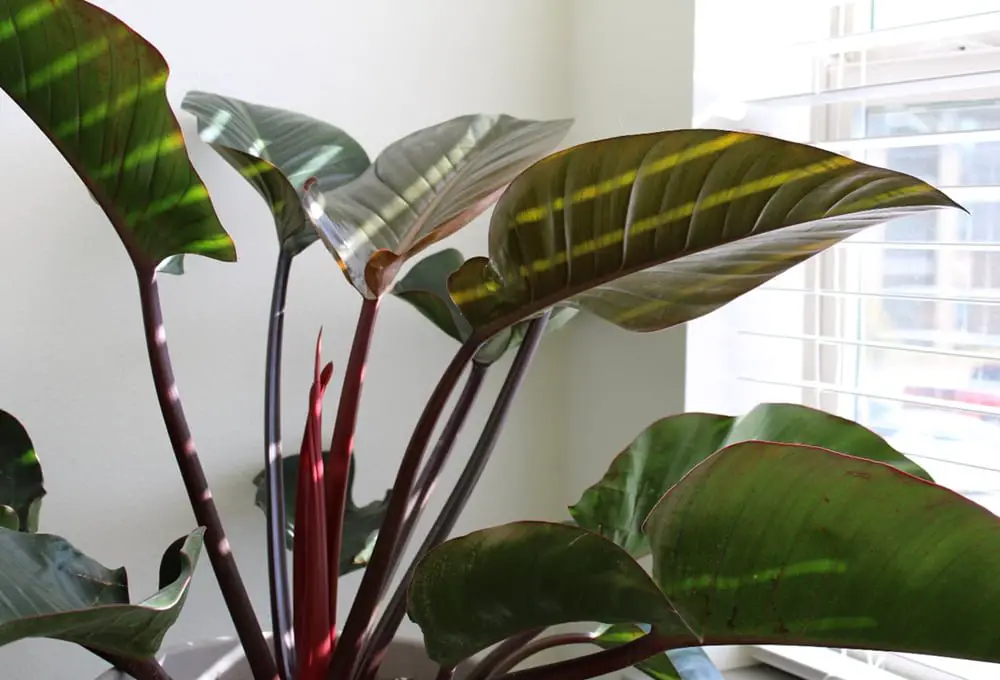
You may have heard of the Philodendron plant, but did you know it isn’t just one plant, but a genus of plants?
Philodendrons are very popular among indoor garden enthusiasts. There are many different Philodendron types to choose from, from climbers to upright plants that look like miniature trees.
Today, we’ll talk about the most popular Philodendron types to help you choose the right one for your home.
Table of Contents
What is a Philodendron?
The Philodendron is a plant native to South American rainforests. In general, Philodendrons have large, dark green leaves, and all varieties produce aerial roots, which grow above the soil and off the stems of the plant.
Aerial roots are meant to stabilize the Philodendron as, in its native habitat, it usually grows against trees and along the floor of the rainforest.
The Philodendron is often confused with the Monstera deliciosa, with both types of plants sometimes being referred to as the Swiss-cheese plant. Some Philodendrons do look like Monstera deliciosa plants, but they are not the same plant at all (more on this later).
Philodendron General Care
Even though every plant has its own individual needs, the Philodendron species is generally easy to take care of, and each plant has similar needs. Whichever type of Philodendron you choose – whether it’s a heartleaf Philodendron or a Philodendron micans – you should have no problem keeping it healthy if you follow a few special tips:
- Philodendron plants like bright, indirect sunlight, mainly because of the needs of their large green leaves. Too much direct sunlight will discolor or even scorch their leaves. It’s best to place them at least three feet away from a south-facing window to ensure there is enough light, but not so much that is directly touching their leaves.
- Your Philodendron’s soil should always be moist, but you should never overwater your plant, or else it may cause root rot. Water your plant until you see the water running through the drainage holes and check the moisture of the soil by placing your finger inches into it.
- The Philodendron is a tropical plant, so it’s used to a lot of humidity. If you live in a dry climate, consider getting a humidifier to add humidity to your Philododren’s air.
Different Types of Philodendrons
As of 2015, there are currently over 480 recognized different types of Philodendron plants, which may make it sound impossible to choose just one.
However, there are definitely varieties of Philodendrons that are more popular than others, and these are the ones that you should consider for your garden.
Here are five different types of Philodendron plants that you might want to consider adding to your indoor garden.
Philodendron Xanadu
The Philodendron Xanadu is an upright growing plant, characterized by its lobed leaves that sit on top of a long stem.
The Philodendron Xanadu’s leaves are a rich green color, which fades if they get too much direct sunlight. Be prepared for this houseplant to grow wider than it is tall.
Philodendron Pedatum
The Philodendron Pedatum is another popular type of Philodendron you’ll commonly find in the homes of plant lovers.
Also known as the Oak Leaf Philodendron, just as with other Philodendrons, the Philodendron Pedatum is known for its large, beautiful leaves.
Their leaves are reminiscent of the shape of oak tree leaves, which explains their namesake, and their leaves continue to change shape as the plant matures.
Split Leaf Philodendron
This is the type of Philodendron that gets most confused with the Monstera deliciosa.
The main reason that these two plants are often confused is because of their holes, which is actually what makes them different from one another.
The Split Leaf Philodendron has splits that run inward from the edge of the leaf, while the Monstra has actual holes throughout the leaf that don’t reach the edge.
In its natural habitat, the Split Leaf Philodendron can grow up to 10 feet high, but the ones you see indoors are more compact varieties that reach a height of only about four-to-six feet.
Philodendron Bipinnatifidum
Next on our list of popular different types of Philodendrons is the Philodendron Bipinnatifidum.
Known by a variety of other names, this plant grows on the floor in its natural habitat, meaning it has aerial roots.
The Philodendron Bipinnatifidum’s leaves are large and dramatic, and they have deep lobes that become more prominent as the plant matures. Its leaves can grow over 14 inches, and it can end up taking up a significant amount of space around it.
Philodendron White Knight
The Philodendron White Knight will have everyone who enters your home asking where you got it.
This eye-catching climbing plant is characterized by its white or cream-colored splotches that sit in striking contrast on its green leaves.
If you want to contain this stunning plant, you can stop the Philodendron White Knight from climbing by giving it a regular trim. This species of Philodendron is rare, so if you find it, make sure you don’t miss your opportunity!
Philodendron Prince of Orange
The Philodendron Prince of Orange lives up to its name with its large orange leaves that catch the eye of everyone who passes.
The Philodendron Orange is especially sensitive to bright, direct sunlight. To ensure that it continues to thrive, make sure that it gets enough shade throughout the day.
This type of Philodendron is a non-climber, but watch out— it can end up doubling in size within a year.
Summary
Philodendrons are becoming an increasingly popular option for plant lovers, and it’s easy to see why. These plants are relatively easy to take care of, and they add a hint of drama in every room they’re in.
There are so many different types of Philodendron plants that it can get difficult to choose the right one for your home. However, no matter which one you choose, it’ll be sure to brighten your house, inside and out.
